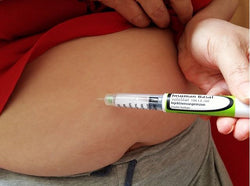Articles
Insulin Temperature Control: What You Need to Know

Published in Healthline. Written by Will Dubois- July 6, 2020
Sunscreen: check. Water bottle: check. Beach ball: check. Insulin cooler….? Yep. For those of us who use insulin, summer heat creates an extra level of complexity and worry.
The real question we all ask ourselves in the heat of the summer is whether our fun-in-the-sun will cook our insulin and leave us having-not-so-much-fun in an air conditioned ICU unit?
Early in 2019, our own Wil Dubois landed in the ER with DKA (Diabetic Ketoacidosis) that seemingly came out of nowhere. This was a wake-up call for him to revisit the basics of type 1 diabetes management, including the importance of keeping your insulin temperature-safe so you know it’s working properly.
Recognizing Spoiled Insulin
What happens when you leave a chunk of raw prime rib out in the sun? Right. After a while, it starts to stink. Guess what? Insulin is the same. Just like prime rib, it’s a protein. And just like prime rib, it can spoil in high temperatures.
Of course, spoiled insulin doesn’t smell rancid. It still smells like Band-Aids. And it doesn’t change color, or give you any other clues that it’s spoiled. It just stops working, or at a minimum it stops working properly, leaving you with blood sugars that start to climb and a need for multiple correction doses that just don’t seem to be making any impact.
You probably knew that, or at least you probably did at one time. But do you know how hot is too hot? Or how long insulin can beat the heat? There are many options nowadays to keep our insulin at ideal temps whether we’re at home, traveling on planes and trains, or out in the wild where weather extremes can present different medication challenges.
What’s the best temperature to store insulin?
The three major insulin makers — Eli Lilly, Novo Nordisk, and Sanofi — tell us that “refrigeration temperatures between 36° and 46°F are maintained for insulin products during the manufacturing process” and that remains the recommended range. They also warn strongly against putting insulin in the freezer, or directly adjacent to the refrigerator cooling element, as freezing renders insulin immediately ineffective.
According to Consumer Reports, the sweet spot for a kitchen fridge is 37° F — apparently ideal for keeping veggies like lettuce free of ice crystals, while suppressing the spread of bacteria. But that’s pretty close to the bottom of the ideal insulin temp range, so we need to be careful.
Many people with diabetes have a habit of taking their insulin directly from the pharmacy to the kitchen fridge. While this is generally good enough, it’s important to be alert to colder corners and know that the overall temperature of a full fridge can be lower than the temperature in a nearly empty one. The butter compartment generally remains a good choice of fridge placement for insulin, as it turns out.
Now let’s turn to the specific insulin you may be using.
Target temps, by insulin brand
Do different insulins have different recommended temperatures for safe storage? Starting with Novo Nordisk, the company that makes more kinds of insulin than anyone else, here’s the official word on product storage:
Long-acting (basal) insulin Levemir, should be kept in a refrigerator at that sweet spot between 36° and 46° Fahrenheit.
Novo tells us that once unopened, vials or pens can be kept safely at room temperature so long as they are protected from heat sources and direct sunlight, and that the medicine will still function for up to 42 days. Apparently, on day 43, it turns into a pumpkin. Wait, what? How is room temp defined?
Well, the problem may be that Novo Nordisk is a Danish company, and it’s cooler in Denmark than in Phoenix, Arizona, or lots of other places. Their official safe room temp for insulin no hotter than 86° F. Meanwhile, open in-use pens and vials, “must NOT be stored in a refrigerator” (the capital letter emphasis is Novo’s), and have the same 42-day life that unopened room temp Levemir has.
Fast-acting (bolus) insulin Novolog has the same temperature ranges, for both unopened or in use, but a shorter (Danish) room temperature lifespan: 28 days. It also has an additional interesting note: Six-days max life in an insulin pump reservoir, unless exposed to temperatures in excess of 98.6° F, in which case it needs to be pitched out.
Pumpers: Don’t snuggle up with someone running a mild fever.
OK, and what about the newest insulin formulations from Novo? Are they more robust than our old standbys? Nope. Ultra fasting-acting Fiasp has the exact same recommendations as Novolog. Ultra long-acting basal insulin Tresiba has the same temps and rules as Levemir, except it apparently lasts a full 56 days at Danish room temps.
What about other brands and formulations? They all have the same 36° to 46° range: Sanofi’s fasting-acting Apidra, and Lilly’s long-acting Humalog/Admelog, Lantus/Basaglar, and Toujeo.
What about insulin mixes? And non-insulin injectable diabetes medications? Yup, they all recommend exactly the same temperature range for safe storage. Just flip to section 16 of the Prescribing Information sheet (basically the Bible for each med) to confirm its ideal temperature range.
Still, just for fun, let’s look at old-school insulin. Was pioneer insulin tougher?
Looking at the data for Novolin R and N — the forerunners of the forerunners of today’s insulins — they too, have the magic 36° and 46° F range, but I guess due to global warming, room temps were cooler back then: 77 degrees. And what about farther back in time? How about animal insulin? We couldn’t find any data for them online (as these insulins predate the Internet), but Merck’s Vetsulin, a pig-based veterinary insulin for cats and dogs, interestingly, it has the exact same temp range.
We queried all the major insulin players on where this temperature standard originated, but didn’t get much information. Novo was the only company to respond, with their Director of Diabetes Communications Michael Bachner writing to say he was unable to locate any sources on why storage temperature “hasn’t changed over the years with newer insulin formulations.”
Tools for keeping insulin cool
The good news is that working insulin — the open vials and pens you’re actively using — doesn’t need to be kept cool, really outside of typical room temperature scenarios. In use, there’s no benefit to actually keeping insulin cold. It will neither prolong its life nor make it work better, plus cold insulin stings when you inject it. The trick is not so much keeping your open insulin cool when in use, but rather, to not let it get hot.
To do this, you just need to make sure your house, work place, car, purse/go-bag, and pocket never get hotter than the top level of Danish room temperature (than 86° F), which nearly every house, work place, car, purse/go-bag, and pocket is sure to hit in the summer here in the USA.
So what to do?
Ice packs were the traditional solution. But while ice packs are great for post-surgical swelling, and may yet be useful in treating hangovers, as a means of keeping insulin cool they’re woefully ineffective. The ice melts quickly, they’re messy, plus they actually keep insulin cooler than it needs to be, at least for working insulin. Ice packs might be a good solution for transporting an inventory of insulin for a day at the pool or beach, or even an extended vacation, but that’s about it.
Thankfully there are some great products to help solve this problem:
- Medicool, which has been around for quite a while, specializes in a wide range of insulated coolers with a molded insert that needs to be frozen, then re-frozen to be used again. It’s a small step up from an ice bag, at least in terms of being less messy, but refreezing takes time. The company also sells a small portable refrigerator.
- The Frio cooling wallets are light, simple, compact, and easy to use. They use evaporative cooling to keep insulin in that sub-80 range for 48 hours, even when the outside temps are well above 100 degrees. To re-use, you just soak the inner sleeve in water and you’re good to go. Frios have the advantage of working in reverse, too, protecting insulin from getting too cold in freezing weather.
- Zhengzhou Dison Electric Co, Ltd. makes a variety of models of portable refrigerators for medicine. How large a variety? How does 62 different models sound to you?
- A new trend in insulin temp control is the use of stainless thermos technology such as the Insulin Safe and its cousins, which can be found on Amazon, eBay, and Aliexpress/Alibaba.
- The novel Vivi products replace the cap of most of the disposable insulin pens on the market, and use phase change material to keep insulin at steady temps for up to 12 hours without electricity, water, or refrigeration. It magically starts working at around 84° and holds the insulin at 82° for either one or two days, depending on the model. They also make a version of their device for insulin vials.
- MedAngel, a compact Bluetooth thermometer you can use to monitor the temperature of your insulin stash while you’re traveling.
So while you can’t leave a chunk of raw prime rib lying around in the sun for too long, you can throw it into your freezer, and thaw it out months later for a good meal. That is sadly not true of insulin, so remember the basics: don’t freeze it, and don’t let your insulin get hot.
Summer can be a key time to keep these tips in mind for those hot and humid days out in the sun, so make sure to be mindful of where you’re insulin is kept when outside.




